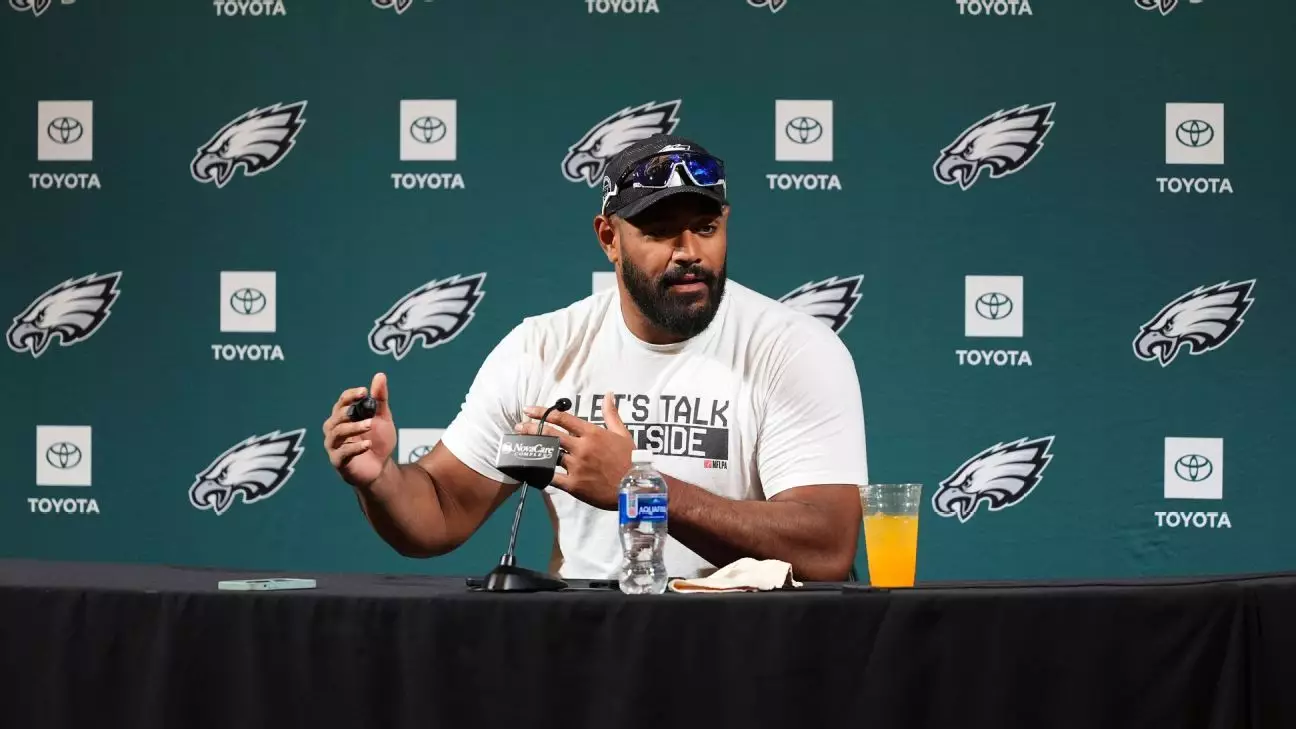In the world of the NFL, strategic maneuvers often ignite debates that dissect the very fabric of the game. At the forefront of this discussion is the “tush push,” a technique employed effectively by the Philadelphia Eagles that has elicited varied responses from players and fans alike. As the NFL prepares for a pivotal vote that could standardize or ban this novel approach, key players, including A.J. Brown and Jordan Mailata, have downplayed its significance, emphasizing that their focus remains on refining their overall offensive strategy rather than battling over a single tactic.
The self-proclaimed “tush push” involves an orchestrated forward thrust where extra players are positioned behind the quarterback, propelling him forward during critical short-yardage situations. This simple yet effective strategy has surged in popularity, particularly with the rise of powerhouses like the Eagles and the Buffalo Bills. Players from these teams have mastered this execution, showcasing the sheer audacity of pushing the boundaries of traditional plays to secure crucial yardage. Yet, as opponents clamor for its ban, one must consider whether such a move would stifle innovation and strategic prowess in the NFL.
Voices from the Eagles’ Camp
The Eagles’ stars have steadfastly embraced an attitude of indifference concerning the potential ban, with Brown expressing a laid-back approach: “It’s only 1 yard.” This candor underscores a broader perspective held by the team. In an era where each inch on the field can impact the game, dismissing the tuck-and-push as trivial may be an oversimplified view. Conversely, Mailata’s criticism of the play’s name hints at a deeper frustration with how their strategy is perceived. He aptly articulates the dichotomy between tactical ingenuity and the tedious back-and-forth of banter surrounding rule changes.
Mailata’s insights reveal a profound understanding of the game; he highlights how the relentless pursuit of championship glory should override worries about rule amendments. The Eagles appear to be resolute, focusing on their offensive schemes and adjusting only where necessary. As he resonantly phrased it, the team should prioritize their game plan over external noise that ultimately will not determine their fate in the upcoming seasons.
The League’s Position and the Chess Match of Football
As the NFL grapples with this legislative turn, voices from executives like Eagles CEO Jeffrey Lurie have led the charge against the proposed ban. Lurie aptly characterized the success of the tush push as a “precision play,” a testament to the confluence of skill and preparation. The proposal to prohibit pushing or pulling the ball carrier across the field may come from a desire to level the playing field, but it also raises questions about the integrity of strategic evolution within the sport.
In Lurie’s view, the essence of football lies in this “chess match.” The game is about outsmarting opponents by forging new paths, whether through innovative plays or unorthodox strategies. To ban a tactic simply because it is being executed well by a select few undermines this fundamental dynamic. Football, at its core, thrives on adaptability and creativity, elements that have always drawn fans to the sport in the first place.
The Data Speaks: Analyzing Success Rates
Supporters of the tush push strategy point to empirical evidence of its success. ESPN Research indicates that the Eagles and Bills have successfully deployed the play with remarkable efficiency—87% of their attempts securing a first down or touchdown, in contrast to the 71% success rate of other teams attempting it. This tangible success raises an important question: should a play that enhances a team’s competitive edge be suppressed in an attempt to create uniformity?
Such statistics provoke deeper reflection on the spirit of competition. Reinforcing the idea that adaptability continues to be the cornerstone of a team’s ability to excel challenges the notion of a one-size-fits-all framework in the NFL.
In light of these discussions and data-driven insights, football enthusiasts find themselves at a crossroads. As teams continue to bend the rules of traditional play to secure wins, it becomes imperative for the league to uphold the very essence of innovation that has made professional football such a riveting spectacle. Rather than restricting what’s deemed unpopular, perhaps a reevaluation of what it means to compete fairly in a sport predicated on strategic evolution is warranted.

